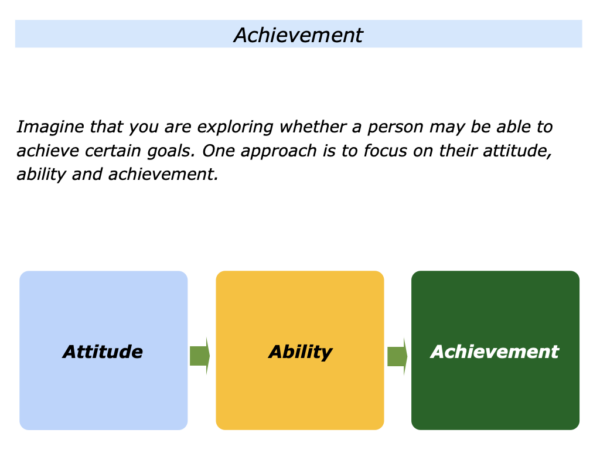
There are many ways to explore whether a person may be able to achieve certain goals. One approach is to focus on whether they have the attitude and ability required to achieve such aims.
This is an approach you can use when interviewing a person for a particular role. Alternatively, you can use it when assessing a person who is already in a role. This involves focusing on the following themes.
Achievement
One approach is to start by clarifying the specific results that a person in this role needs to deliver. Much will depend, of course, on the particular role.
The results they are expected to deliver will differ if they are working as a nurse, sales person, technical specialist, customer services director, leader or in another role.
One key point is worth underlining. It can be useful to describe the specific things they are to deliver in outcome terms. Let’s look at one example.
Imagine that a person is to lead a team. The outcomes want them to deliver may include the following:
To make clear contracts with their key stakeholders about the specific outcomes to deliver in terms of their team’s profitability, product quality and people morale;
To lead a superb team that delivers the desired outcomes in terms of profitability, product quality and people morale;
To focus on continuous improvement and, when appropriate, implement ideas that maintain or improve the team’s performance in terms of profitability, product quality and people morale.
Imagine you are a recruiting a nurse to work in a hospice. You will probably look for somebody who demonstrates compassion, medical competence and who can support their colleagues. They may also need to be resilient and able take care of their own wellbeing.
Let’s return to focusing on a person who may be applying for role or you may be assessing the performance of a person who is already in a role. If you wish, try tackling the exercise on the theme of achievement.
First, describe the specific role. Second, describe the specific results – the specific outcomes – you would like a person in this role to deliver. Here is the exercise.
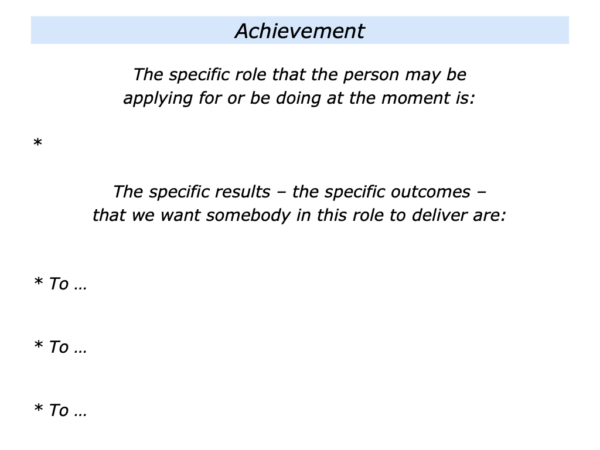
Let’s assume that you have clarified the results to a person needs to deliver. You may then want to focus on the following theme.
Attitude
What is the attitude a person may need to demonstrate in order to succeed? Depending on the specific role, they may need:
To encourage other people … To be positive … To behave in a professional way … To be good at making clear contracts … To have a strong service ethic … To be resilient … To demonstrate other characteristics.
Will the person be working alone or with other people? If the latter, then it is important to ask the following questions.
What is the person’s style of interacting with other people? How do they communicate with and relate to people? What are the consequences of the person’s style?
How do people feel after interacting with them? What will be the effect they person’s style may have on their colleagues, customers and other stakeholders?
Imagine you are interviewing a person for role. How can you get some clues about their attitude? Let’s look at one approach.
The Principles Driven Approach
Some organisations aim to recruit people who embody the organisation’s principles. Before interviewing a candidate they send them the organisation’s culture handbook. This describes:
The specific principles it encourages people to follow on the way towards achieving the organisation’s goals;
The specific reasons for following these principles on the way towards achieving the organisation’s goals
The specific examples of how people have translated these principles into action on the way towards achieving the organisation’s goals.
The organisation then invites the candidate do some prework and to present at the interview. The person is asked:
To describe a specific situation in the past when they have aimed to follow some of these principles in their personal or professional lives;
To describe the specific things they did to translate some of these principles into action;
To describe the specific things they would aim to do to follow some of these principles in their potential work for the organisation.
This sounds like a lot of work. But the way the candidate tackles the exercise can say a lot about their attitude.
Imagine that you are interviewing a person or focusing on somebody who is already in a role. Looking at their behaviour, you can explore the following themes.
What is the attitude the person needs demonstrate to deliver the desired results? When have they demonstrated these qualities in the past?
On a scale 0-10, to what extent do they demonstrate the required attitude? Anything less than 7+10 is a danger signal.
What are the specific things they can do to maintain or improve the rating? If appropriate, are there any things we can do to help them to take these steps?
If you wish, try tackling the exercise on this theme. This invites you to complete the following sentences.
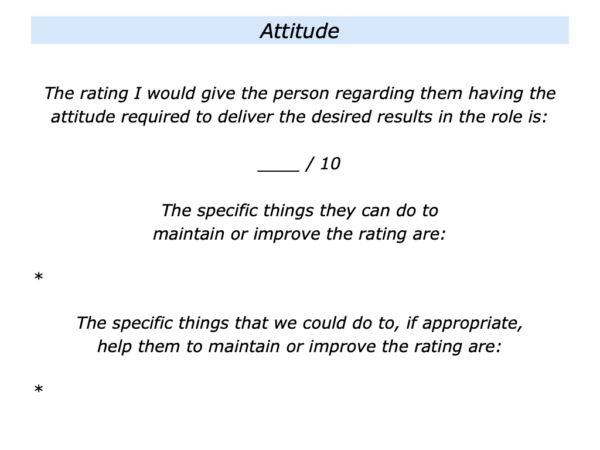
Ability
Attitude is good starting point but the person must also have the ability to deliver the goods. The person will need to demonstrate certain strengths if they are working as a counsellor, sales person, leader or in another role.
Bearing in mind the results to deliver, what are the qualities the person needs to demonstrate? Depending on the role, they may need to be caring, make clear contracts, manage customers, give great service or have other skills.
How to clarify whether the person has the required abilities? This can be easier if you know person and have seen them in action. You are then able:
To clarify when the person has demonstrated these abilities;
To clarify their areas for improvement.
How to do this if you are interviewing a candidate? One approach is to explore their positive history and invite them to do the following things:
To describe two satisfying and successful projects they have done in their life;
To describe what made each of these satisfying;
To describe the actual things they did – in behaviour terms – to deliver success.
Look for any recurring patterns. These can give clues to a person’s successful style of working and whether they may have the ability to deliver the desired results.
Imagine you have focused on the person’s abilities. It can be useful to explore the following questions.
What are the abilities the person needs to demonstrate to deliver the desired results? On a scale 0-10, to what extent do they have these abilities?
What are the specific things they can do to maintain or improve the rating? If appropriate, are there any things that we can do to help them to take these steps?
If you wish, try tackling the exercise on this theme. This invites you to complete the following sentences.
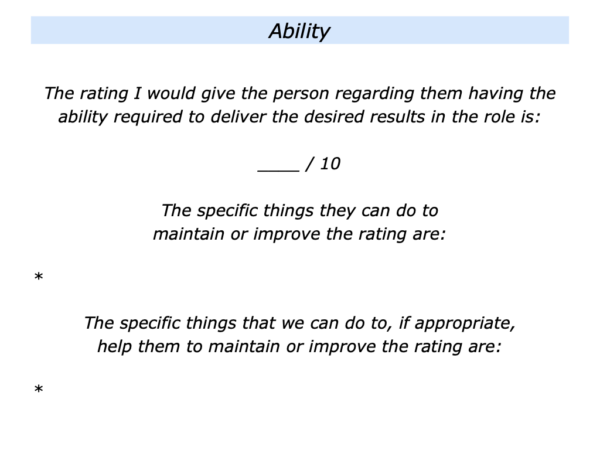
Achievement
A person’s attitude and ability provides the foundation for them working towards achieving success. It will then be important for them to apply themselves properly and deliver the desired results.
Depending on the role, they may need to score highly in some of the following areas:
To follow the strategies most likely to achieve success … To be self-managing … To keep doing the right things in the right way every day … To deliver consistently high professional standards.
To perform superb work … To enable other people to perform at their best .. To proactively keep their stakeholders informed about their progress towards achieving the goals.
To find solutions to challenges … To deliver great service … To help their customers and colleagues to achieve success … To make their best contribution to helping the organisation to shape a positive future.
How to clarify whether a person is likely to perform a role successfully? Bearing in mind the person’s successful and unsuccessful patterns, it can be useful to explore the following questions.
What are the specific results – the outcomes – that a person needs to deliver in the role? When has the person delivered these or similar outcomes in the past?
What did they do right then to deliver the outcomes? What were the strategies they followed? How did they translate these into action? What happened as a result?
What are the person’s strengths? How could they build on these strengths to achieve the goals? How could they manage the consequences of any weaknesses?
On a scale 0-10, how high would I rate the likelihood of the person delivering the desired results? What could they do to maintain or improve the rating? If appropriate, what could we do to help them to maintain or improve the rating?
If you wish, try tackling the exercise on this theme. This invites you to complete the following sentences.
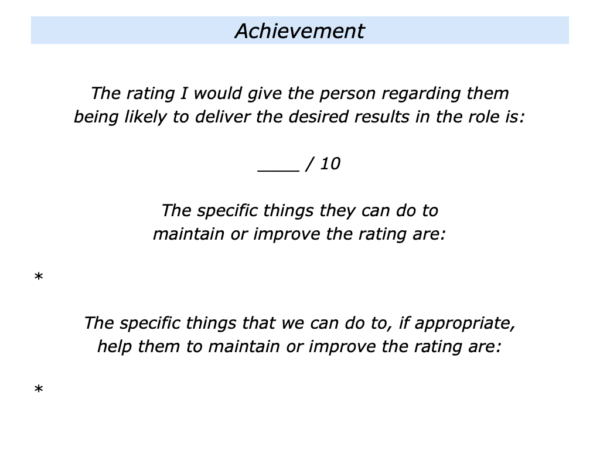
The Summary And Recommendations
Imagine that you have gone through the previous steps. If appropriate, you may then want to bring everything together. This can involve focusing on the following themes. You can aim:
To describe the ratings you have given under the headings of the person’s attitude, ability and the likelihood of them delivering the desired results;
To describe the reasons for giving these ratings under each of the headings.
To summarise your recommendations regarding the person and the role together with any suggestions about the possible next steps.
You may believe, for example, that: a) the person will be able to deliver the results; b) the person may be able to this if they improve in certain areas or get support; c) the person is not suitable for the role.
Bearing in mind your recommendations, you may also offer suggestions regarding the person or the role. These could include some of the following. You could suggest it may be appropriate:
To offer the person the role, make clear contracts about the outcomes to achieve and set them up to succeed;
To explore whether it may be more appropriate to invite the person to consider another role in the organisation;
To continue the search for another person who may be more likely to succeed in the role.
Here is a framework you can use to summarise your findings. This invites you to describe whether you believe the person has the required attitude and ability.
You can then give your recommendations regarding the likelihood of them delivering the desired results in the role. It also provides space for you making suggestions regarding the possible next steps.
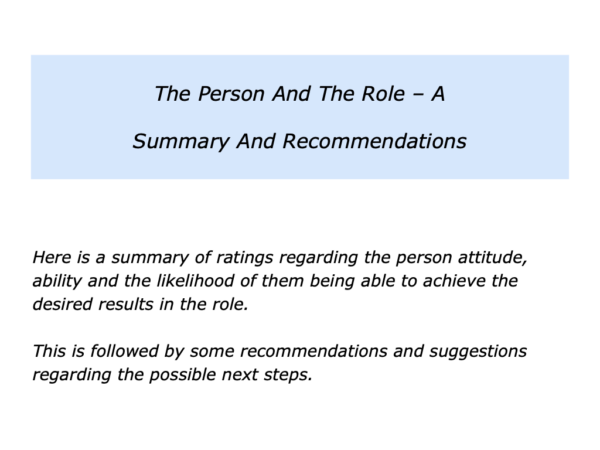
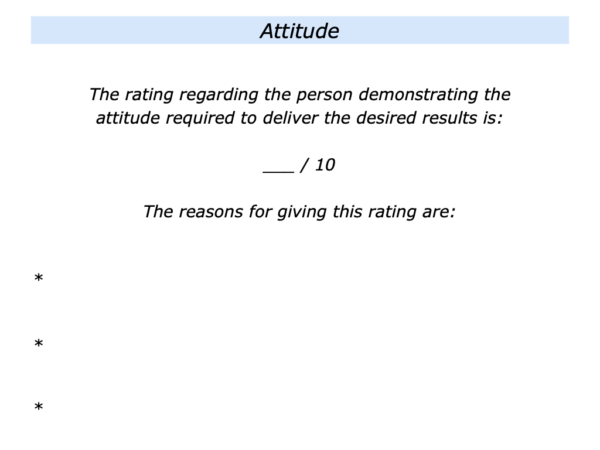
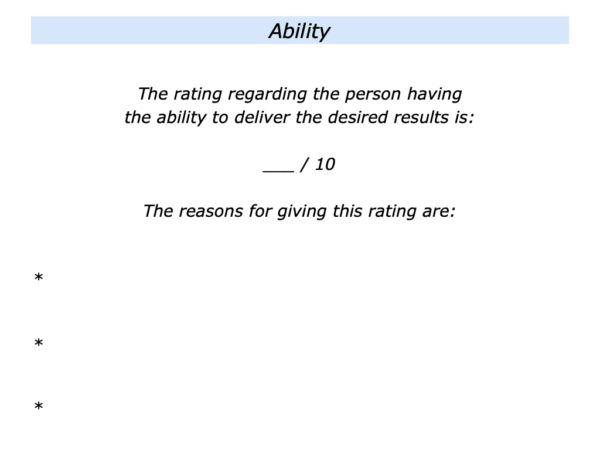
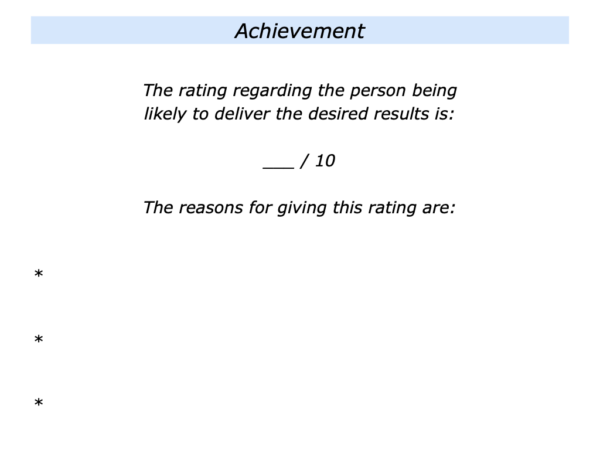
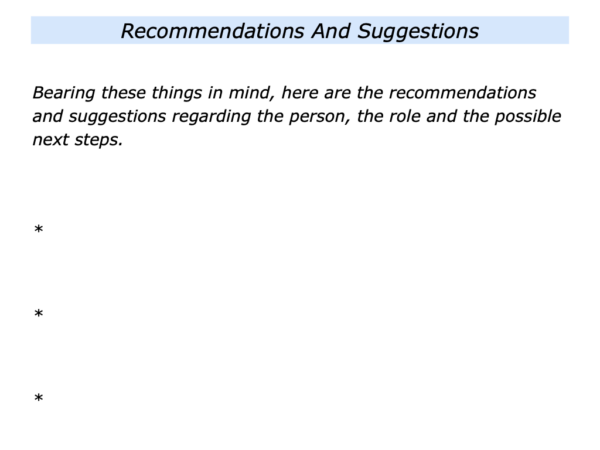


Leave a Reply